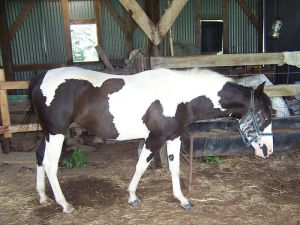This is Part 11 of a 47-part series of almost-weekly blog posts looking at curries from each of Japan’s 47 prefectures.
So hungry you could eat a horse? Then you should visit Kumamoto Prefecture, where horse meat is a well-known feature of the local culture.
This makes Kumamoto distinctive, since meat of any kind has played only a small role in the history of Japanese cuisine. In fact, eating it was usually taboo.

If you squint just right, this horse looks kind of like a cow. (JD Lamb photo via Wikimedia Commons)
In her fascinating book “Modern Japanese Cuisine,” historian Katarzyna J. Cwiertka writes, “The first decree prohibiting meat eating in Japan was issued in AD 675.” Today it is commonly believed that such rules were based on Buddhist beliefs, but Cwiertka argues that the real purpose was to protect big livestock – horses and cattle – needed for plowing and transportation. Once the ban was in place, Buddhism may have reinforced it, but it seems to have applied mainly to domestic animals rather than wild game.
But even game carried a whiff of the unsavory. During the Edo period (1603-1868), there were “beast restaurants” that served meat for “medicinal” purposes. Cwiertka writes, “The fact that euphemisms were used when referring to various types of meat indicates that the aura of defilement was associated with the game stew served there. Sakura (cherry) signified horsemeat, momiji (maple) venison and botan (peony) wild boar, the last also being known as ‘mountain whale’ (yamakujira).”
How, when and why eating horse meat took particular root in Kumamoto is unclear, but one theory (described in an article by Jesse Veverka) holds that Kato Kiyomasa, daimyo of what is now Kumamoto prefecture, on the southwestern island of Kyushu, sanctioned it in response to a war-induced famine in the 1590s.
Nowadays, horse accounts for almost exactly one percent of Japan’s annual meat production. Of approximately 500,000 tons of meat produced domestically each year since 2009, about 5,000 tons comes from horses. Japan imports horse meat, too – roughly 1,360 tons in the first four months of 2013, compared to about 45,800 tons of beef imported in the same period, according to agriculture ministry statistics.
That’s a lot of meat, and there are a lot of ways to serve it.
In her handy reference book and dining guide “Food Sake Tokyo,” Yukari Sakamoto writes about horse meat, “The lean meat of the neck is eaten braised or ground; the tender parts like the fillet are eaten rare; the back leg, rich in fat and collagen, is slow-cooked for a long time so that it becomes tender. The liver, sliced thinly, is sometimes eaten raw.” She goes on to describe additional preparations, such as sashimi-style raw horse (basashi), grilled horse and a shabu-shabu-style hot pot dish called hari hari nabe.
I’ve eaten basashi at izakayas a few times over the years, dipping slices of the meat in soy sauce with grated ginger. Perhaps I haven’t gone to the right places, but I’ve found the meat to be overly chewy and not memorably flavorful. It’s not at all unpleasant, but it struck me as being in the category of things one eats just to say one has eaten them.
However, the horse meat curry I tried a few days ago was much nicer than that. It included chunks of what I would consider good stew meat – soft and just slightly stringy, easy to break up with the edge of a spoon. Some of the meat had little bits of tendon attached, with the collagen softened by long cooking. (I was content with the quantitiy of meat I got, but it was nothing like the generous mountain shown in the photo on the box.)
It was a rather mild curry, but the spiciness was dialed down without being replaced by the overt sweetness that often characterizes mild curries in Japan. The sauce reminded me of what you might get if you made a standard brown gravy with meat drippings, thickened it with more than the usual amount of flour and then added just a dash or two of cayenne pepper or chili powder.
 When I checked the ingredient list, sugar was more prominent than I had expected. But then, sugar is in everything these days. Otherwise, the main ingredients bore out my first impressions. The top nine were horse meat, fat (beef and pork), flour, sugar, starch, salt, curry powder, fond de veau (veal stock), and sautéed onions.
When I checked the ingredient list, sugar was more prominent than I had expected. But then, sugar is in everything these days. Otherwise, the main ingredients bore out my first impressions. The top nine were horse meat, fat (beef and pork), flour, sugar, starch, salt, curry powder, fond de veau (veal stock), and sautéed onions.
In addition to the main meat, there were a several other umami ingredients such as tomato sauce, cheese and pork bouillon. There were also a few surprise items such as banana, honey, peanut butter and cocoa.
This was a nice curry. I enjoyed it without finding it particularly exciting. I think my timing may have been off. If I had eaten this horse meat curry on a cold winter night instead of a hot summer day, I’m sure I would have found it immensely satisfying.
Tags: Around Japan in 47 curries, curry, horse, horsemeat, Kumamoto, meat


Leave a comment